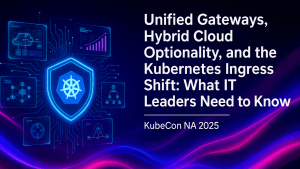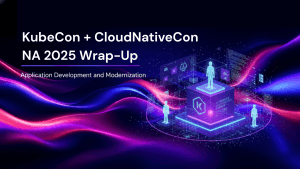The Kubernetes ecosystem continues to evolve rapidly, and with it, the architectural decisions facing enterprise technology leaders. At KubeCon North America 2025, two trends stood out prominently: the accelerating push toward hybrid and multi-cloud architectures, and growing fragmentation across gateway, networking, and AI/MCP orchestration layers. These pressures are converging at the same time that one of the most widely used ingress solutions (Ingress NGINX) faces an impending end-of-life.
At KubeCon NA 2025, theCUBE Research’s Paul Nashawaty sat down with Sudeep Goswami, CEO of Traefik Labs, to unpack these shifts. The conversation explored unified gateway strategies, the operational demands of sovereign and hybrid deployments, and the industry-wide implications of Kubernetes SIG Network’s retirement of Ingress NGINX.
The Push Toward Hybrid, Multi-Cloud, and Sovereign Flexibility
The most consistent trend emerging from both KubeCon sessions and enterprise briefings is the normalization of hybrid and multi-cloud as standard operating models. Organizations are increasingly rejecting rigid architectural patterns in favor of location-agnostic deployment models that give them flexibility across public cloud, private cloud, and sovereign environments.
From an analyst perspective, this shift is driven by three forces:
• Cost optimization pressure: Enterprises are moving workloads between environments to chase better economics, especially for AI inference and high-throughput services.
• Regulatory and sovereignty concerns: Sectors such as financial services, healthcare, and public sector now require portable architectures that can run fully offline or in geographically restricted zones.
• Operational consistency mandates: Platform teams want a single operating model across VM, container, and serverless workloads, eliminating the tooling silos that have accumulated over the past decade.
During the interview, Goswami emphasized that customers “want to be able to run infrastructure wherever they want,” with a consistent management and policy framework. This aligns with theCUBE Research findings: more than 60% of enterprises now describe hybrid cloud not as a strategic choice, but as a requirement imposed by business, regulatory, and performance constraints.
The Case for a Unified Gateway Strategy
A notable portion of the discussion focused on the consolidation of gateway functions across API, AI, and MCP (Model Context Protocol) workloads. Today’s enterprises often operate:
- API gateways for service connectivity
- AI gateways for LLM routing, caching, and safety enforcement
- MCP gateways for agent execution, tool access, and cross-system orchestration
IT leaders increasingly view this fragmentation as an unnecessary operational burden. Each gateway type introduces separate:
- configuration models
- scaling behaviors
- logs and traces
- policy enforcement pipelines
- upgrade and failover processes
As Goswami noted, “Deploying three different gateway products is a non-starter.” The industry appears to be validating this position. Agentic workflows are introducing new complexity: AI agents calling APIs, APIs invoking tools through MCP, and LLMs generating actions that trigger downstream services. This interconnectedness reinforces the need for a unified, multi-protocol gateway capable of handling:
- LLM-to-agent traffic
- agent-to-API operations
- agent-to-resource access
From a decision-maker viewpoint, unification reduces fragmentation, simplifies day-two operations, strengthens governance, and helps standardize observability pipelines. This consolidation trend is likely to accelerate as agent-based architectures move mainstream.
The Rise of Declarative, Infrastructure-as-Code Operational Models
Enterprises are also changing their operational expectations. Declarative configuration and infrastructure-as-code (IaC) models have moved from “developer preference” to “organizational mandate.”
Key drivers include:
• Day-two operations: Teams want upgrades, rollouts, and policy changes to be fully automated and environment-independent.
• Workforce constraints: Platform teams increasingly support hundreds of developers with limited staffing, making automation essential.
• Governance and auditability: Regulated industries require consistent enforcement mechanisms across regions and deployment environments.
Traefik’s early investment in a fully declarative design serves as an interesting market case: technologies with IaC-first operating models appear to be achieving stronger enterprise adoption due to lower operational overhead and improved compliance posture.
The Ingress NGINX EOL: A Significant Ecosystem Disruption
The Kubernetes SIG Network announcement that Ingress NGINX will be retired in March 2026 (with no future maintenance, bug fixes, or enhancements) was one of the most consequential updates of the event. Compounding the impact, InGate, the intended successor, has been discontinued due to insufficient community participation.
The scale of disruption is notable:
- 41% of internet-facing clusters rely on Ingress NGINX, according to industry surveys.
- Numerous managed Kubernetes services use Ingress NGINX as their default ingress controller.
- Enterprises with tightly regulated clusters now face accelerated migration timelines.
For IT leaders, this raises immediate concerns:
- What is the safest migration path with minimal downtime?
- Which ingress controller offers operational maturity and OSS longevity?
- How do we mitigate the risk of similar ecosystem disruptions in the future?
Traefik Labs’ release of a drop-in Ingress NGINX provider offers one migration path, but leaders should carefully evaluate compatibility, policy portability, and tooling impact regardless of the chosen solution.
What IT Decision Makers Should Do Now
Based on theCUBE Research analysis, IT leaders should consider the following actions:
1. Begin evaluating ingress alternatives immediately.
With only months to migrate, teams should test replacement controllers in staging environments.
2. Pursue gateway consolidation where possible.
Unified AI/API/MCP gateways reduce configuration sprawl and governance inconsistencies.
3. Modernize toward declarative operations.
IaC-driven models materially reduce operational risk across hybrid and sovereign environments.
4. Prioritize portability across clouds and sovereign regions.
Architect for movement, not just deployment as regulatory and cost pressures will continue to shift.
5. Reinforce open-source governance vetting.
Ensure that critical components have sustainable communities, corporate backing, or both.
Final Perspective
The industry is entering a new phase of architectural standardization where hybrid optionality, unified gateways, and portable operational models determine long-term agility. The retirement of Ingress NGINX highlights the risk of overreliance on any single open-source component without evaluating community health and roadmap stability.
As infrastructure complexity increases and AI-driven workflows mature, IT decision makers will need to align around platforms that deliver consistency, predictability, and portability across all environments. The organizations that prepare now will be best positioned to navigate the next wave of distributed application evolution.



